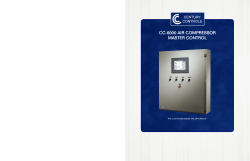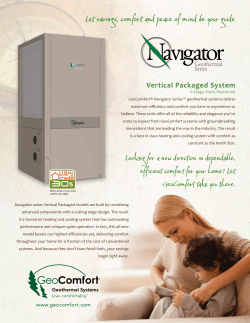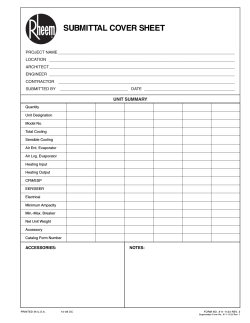
How to recover heat from a compressed air system
How to recover heat from a compressed air system Over 90% of the electrical input to a compressor is lost as heat. Companies can reduce their consumption of heating fuel by recovering waste heat from air and water cooled compressors and save money. The business case Many businesses gain significant financial benefits from installing waste heat recovery equipment, especially if their site has long operating hours. In many companies, the cost of recovering warm air can be recouped in less than a year, while hot water systems can pay back investment in less than two years. There are many types of compressors found in industry. The air cooled oil injected rotary screw compressor is the most common however other configurations such as piston, vane, oil free screw and centrifugal compressors are seen. Waste heat can be recovered from all types of compressor in the form of hot air or hot water with typical savings as shown in Table 1. Table 1 Typical heat availability from compressors Compressor capacity Nominal motor rating Annual heat available (2000 hrs/year) Savings potential cfm kW kWh 90 15 24,000 £706 125 22 35,200 £1,035 350 55 88,000 £2,588 700 110 176,000 £5,176 1000 160 256,000 £7,529 1250 200 320,000 £9,412 1550 250 400,000 £11,765 • Assumes 2000 hours per year operation • Savings based on replacement of gas heating with a boiler efficiency of 85% and a gas cost of 2.5p/kWh How to recover heat from a compressed air system 2 Heat recovery systems are particularly beneficial for sites with demands for hot water or heating. The types of sites and possible applications include: Figure 1 Heat balance within a typical oil injected rotary machine • water heating. Input shaft power from motor 100% • space heating. • process heating and drying. • boiler houses for feed water or combustion air. Heat from electric motor 9% • compressed air plant using heat to regenerate desiccant dryers. Figure 1 on the right, shows the heat balance within a typical oil injected rotary machine when running at full load. Radiation loss 2% Heat from oil cooler 72% Remaining heat in compressed air 4% The technology Recoverable heat from after-cooler 13% The choice of system depends on the type of compressor, its cooling system and how the recovered heat will be used. The following diagrams show the type of heat recovery possible from compressors and the technology needed to use that heat. Recoverable heat 94% Temperatures of up to 80ºC can be reached in the discharge ducting. Figure 2 Typical air cooled package used for space heating To atmosphere To factory Dampers External air Air compressor The dampers can be automated to provide heating as when required. This system is simple to install, but the benefit only enjoyed when heating is required. If there is a need for domestic or process hot water it is more beneficial to install an energy recovery unit linked to the oil cooler of an air cooled package as shown in Figure 3 on page 3. How to recover heat from a compressed air system 3 Figure 3 Energy recovery unit Shower Compressor Plate Heat Exchanger Hot Water Storage Standard water cooled compressors provide only low temperature heat, normally 25-40ºC in the cooling water but can be specially arranged for waste heat recovery from the intercoolers and aftercoolers at temperatures up to 80ºC. Specification checklist The first step before investing in a heat recovery system is a feasibility study to identify the source of the heat, the quantity available and the area where the heat will be used. Table 2 outlines the points to consider. For the system to make financial sense, compressors generally need to be above 15kW. Energy costs are constantly changing, though, so it is worth checking against the latest rates. Table 2 Specification checklist Heat availability Heat requirements Matching heat to demand How much heat is available? How much heat can be used? Is heat available at the required temperatures? When is the heat available? When is the heat needed? Do the heat recovery times match the demand times? Where is the heat available from? Where will the heat be used? Can the heat be transferred efficiently between locations? How to recover heat from a compressed air system 4 Commissioning checklist Getting the commission stage right is crucial to a smooth-running system. Table 3 sets out the basic steps for all types of systems. Table 3 Commissioning procedure Action Comments Carry out all health and safety checks on rotating equipment. Ensure that all operating and maintenance manuals are in place. Train all operating and maintenance people and explain the new system and its benefits. Test the operation of each element. This will identify any local problems with the equipment. Open the air dampers, if air is to be re-circulated, or open the valves on water based systems. Start any pumps or fans. Measure the heat flow from the compressor and the heat recovered. This will confirm the system is meeting objectives and will pay back costs within the time specified. Monitor the energy consumption in areas where the recovered heat is being used. This will check that control systems are reducing energy consumption. Common problems Further information You should always consider the following if you are thinking about using heat recovery: For more information see GPG238 • If warm air is being used for space heating, you may need to use automatic controls to avoid overheating the building. • If recovered heat is used to pre-heat boiler combustion air, check with the burner manufacturer that the fans can cope with the raised air temperature. • You may need to install filters or noise dampers if you are using air direct from a compressor. • Discuss all ducting with the compressor supplier to avoid backpressure on the package that may compromise its cooling and efficiency. Consider using specialist consultants or contractors to work out the optimum size for any heating plant. The Heating and Ventilating Contractors Association (HVCA) 0207 313 4900 www.hvca.org.uk Chartered Institution of Building Service Engineers (CIBSE) 0208 675 5211 www.cibse.org • Use booster fans in ducts to avoid backpressure problems. • Pipe all safety valves outside of oil injected packages used for space heating to avoid odours in factory. • Fire dampers may be required if ducting passes through fire walls. Legal information
© Copyright 2025





















